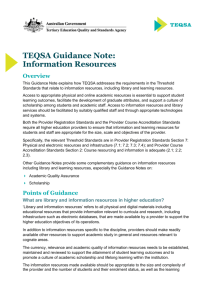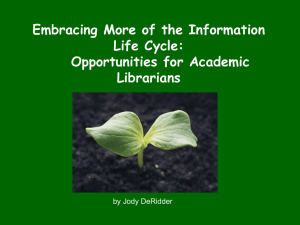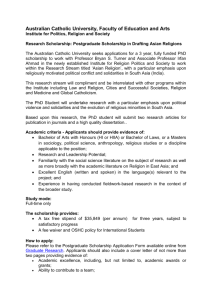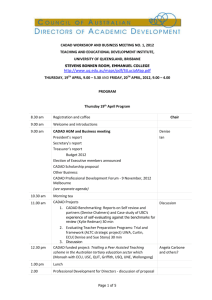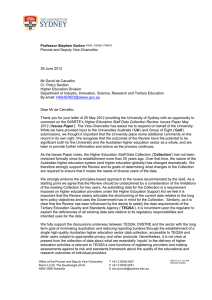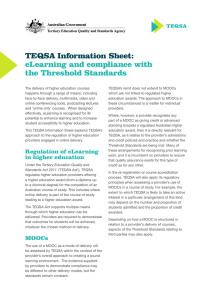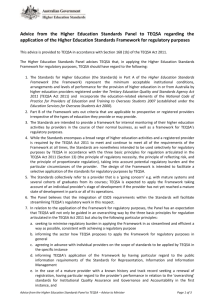DOCX 105KB, 3 pages - Tertiary Education Quality Standards Agency
advertisement
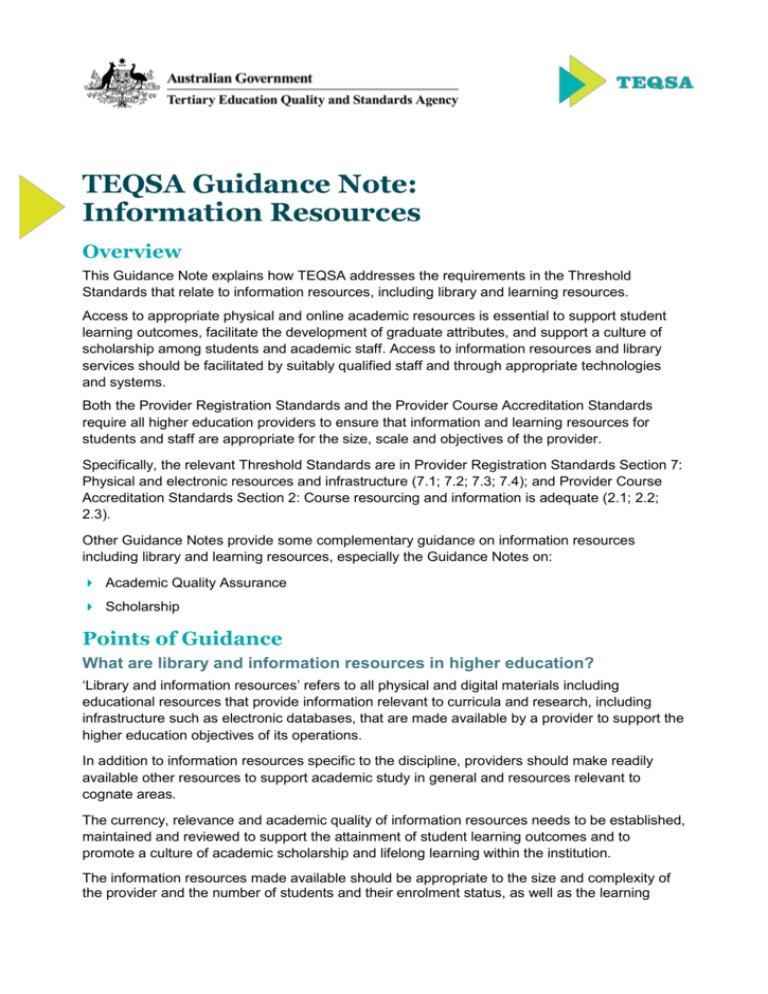
TEQSA Guidance Note: Information Resources Overview This Guidance Note explains how TEQSA addresses the requirements in the Threshold Standards that relate to information resources, including library and learning resources. Access to appropriate physical and online academic resources is essential to support student learning outcomes, facilitate the development of graduate attributes, and support a culture of scholarship among students and academic staff. Access to information resources and library services should be facilitated by suitably qualified staff and through appropriate technologies and systems. Both the Provider Registration Standards and the Provider Course Accreditation Standards require all higher education providers to ensure that information and learning resources for students and staff are appropriate for the size, scale and objectives of the provider. Specifically, the relevant Threshold Standards are in Provider Registration Standards Section 7: Physical and electronic resources and infrastructure (7.1; 7.2; 7.3; 7.4); and Provider Course Accreditation Standards Section 2: Course resourcing and information is adequate (2.1; 2.2; 2.3). Other Guidance Notes provide some complementary guidance on information resources including library and learning resources, especially the Guidance Notes on: Academic Quality Assurance Scholarship Points of Guidance What are library and information resources in higher education? ‘Library and information resources’ refers to all physical and digital materials including educational resources that provide information relevant to curricula and research, including infrastructure such as electronic databases, that are made available by a provider to support the higher education objectives of its operations. In addition to information resources specific to the discipline, providers should make readily available other resources to support academic study in general and resources relevant to cognate areas. The currency, relevance and academic quality of information resources needs to be established, maintained and reviewed to support the attainment of student learning outcomes and to promote a culture of academic scholarship and lifelong learning within the institution. The information resources made available should be appropriate to the size and complexity of the provider and the number of students and their enrolment status, as well as the learning outcomes of each course provided. They should be accessible to all students regardless of the mode of course delivery. Key features for the effective management of information resources Responsibility for the provision of information resources, including library services, is reflected in policy, strategy and planning processes at an institutional level. There is an effective information resource plan or strategy, that addresses acquisition, retention, culling and renewal. o Budget allocations for information resources, including library services, should be adequate, integrated into annual financial projections and aligned with course delivery and research requirements and student projections accordingly. Information resources are managed by suitably qualified and experienced staff to support and identify the learning needs of students. Information resource staff liaise with academic and support staff to ensure a comprehensive and integrated resource collection and system, and support the scholarly and research practices of the provider. There are adequate library and information systems to enable ready access to information resources for students and staff on and off campus, regardless of their location and mode of study. Students unable to attend a campus with a library should have access to all information resources needed to complete the course by some other means, such as through a Learning Management System. Full-text, digital access is available to students and staff for information resources listed as required on academic outlines including book chapters, journal articles, and conference papers, and to support scholarship and research in the field of education. The performance of information resources provision is periodically reviewed o Student feedback mechanisms and benchmarking activities are built into review systems of information resources and acted on where appropriate. o Data is collected and analysed in relation to the usage of resources and information systems to monitor and enhance student experience. There are appropriate and accessible physical spaces for information resources including library services and related student study, as appropriate to the provider’s mode of delivery. The library operating hours are appropriate for all students and staff to ensure reasonable access to information resources, including library services. Arrangements with other providers Some providers develop partnerships or enter into arrangements with other organisations that have larger collections, including universities, to supplement their own collections. In some cases such an arrangement will facilitate full access for students to other libraries. The following considerations should be taken into account when arrangements with other partners and/or other libraries are developed: Are the library collection, facilities and services of the partner appropriate to support the learning outcomes of higher education students at the required level, and to support the needs of academic staff to perform and undertake teaching and learning duties and/or Guidance Note - Information Resources required research and other scholarly activities, where applicable? If not, what access to the registered provider’s library will be made available? Is there a written agreement that clearly outlines the responsibilities of both the partner and registered provider to provide access to information resources, including library services, to all cohorts of students and levels of staff? For example, does the agreement ensure that students and staff have reasonable access to physical materials? Are borrowing rights available? Is remote access to digital collections, including databases and e-books, included in the scope of the agreement? Does the arrangement present an extra cost to the student? If students will need to pay specific fees (i.e. additional to the course fee) for access to another library collection, is this information clearly communicated to students prior to enrolment? Are information resources readily and easily accessible to all students both geographically and digitally? Is the physical distance between the provider and the partner library a barrier to student access? Is the arrangement financially sustainable and is it appropriate to support projected student enrolments and growth? Are the students actively encouraged to use the resources at the third party? Things to consider TEQSA recognises that approaches to information resources will vary over the diverse range and scale of higher education providers. New providers will need to show how they will scale their information resources in order to align with expanding course delivery and projected student numbers. Advocating the use of public or community libraries as a primary information resource to support the higher education operations of a provider does not demonstrate an appropriate approach to the provision of information resources for higher education. Further, advocating the use of free online resources as a primary information resource, rather than as a supplementary or secondary information resource, to support the higher education operations of a provider does not demonstrate an appropriate approach to information resources for higher education. References Australian Library and Information Association: https://www.alia.org.au/ Council of Australian University Librarians: http://www.caul.edu.au/ Quality Assurance Agency, (2014) Subject benchmark statement: Librarianship, information, knowledge, records and archives management - draft for consultation, UK Note: This guidance note has been developed in consultation with the Australian Library and Information Association and the Council of Australian University Librarians. TEQSA Contact For further information about or discussion regarding information resources please contact your case manager in the first instance. Guidance Note - Information Resources
